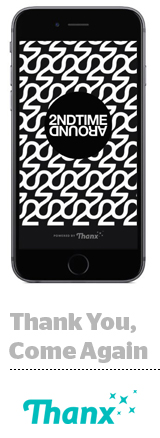 There was a problem with 2nd Time Around’s paper-based loyalty program. No one was using it.
There was a problem with 2nd Time Around’s paper-based loyalty program. No one was using it.
“It was an inconsistent experience, it wasn’t trackable and we didn’t get any data out of it,” said Kristin Kohler Burrows, president and CEO of 2nd Time Around, a fashion consignment retailer that operates more than 40 stores across the East Coast and Chicago.
Roughly six months after Burrows, formerly president of sneaker brand Keds, joined 2nd Time in November 2014, she did away with the program and shortly thereafter hooked up with Thanx, a customer loyalty startup that helps retailers and restaurants take their loyalty programs mobile.
Rather than loyalty tied to the point of sale, like Square, Thanx links loyalty to credit cards through integrations with Visa, MasterCard and American Express.
Consumers download the Thanx branded app, select a merchant – Thanx works with several hundred – and register their credit cards. From there, consumers make purchases as usual, and rewards are automatically accrued and applied whenever there’s a card swipe at a brick-and-mortar location.
Thanx rounds out its offering with a suite of marketing and engagement tools, including feedback, churn management and messaging, all of which are tied back to transactions or specific in-store experiences.
On Tuesday, Thanx launched a service that allows merchants to create their own stand-alone branded loyalty apps outside of the main Thanx app. 2nd Time Around is one of the first brands to give it a go. Its app is set to hit the app stores on April 20.
For Burrows, the core benefit is around CRM – segmenting top customers, identifying lapsed shoppers and keeping track of average check orders. In June, it will integrate all of that with 2nd Time’s ecommerce site.
“The data piece is really important to us,” said Burrows. “Right now, we really only have one type of customer we reach out to – the treasure hunter – because of the way our business model works.”
Unlike other retailers with stockpiles of inventory, most of the items for sale at 2nd Time are single units. A consignor generally comes in with one Hermès belt or one David Yurman ring, not 500 of each.
From the consumer’s perspective, it’s an arrangement that lends itself to aimless browsing. A “come in and you never know what you’re going to find” sort of thing.
But among the treasure hunters, there’s a segment of what Burrows calls “spearfishers” – shoppers on the lookout for a particular item. Months might go by without it being available, and when a one-off piece of inventory finally hits a certain store, there’s no easy way other than a mass email to reach the small subset of people who would want it.
As 2nd Time grows its database and learns more about its shoppers, their habits and their specific preferences, real-time targeted push notifications around specific items will become part of the strategy, especially to bigger spenders and more VIP-like customers.
“We’ve been in the business for almost 40 years, but it’s really just recently that we’ve been on this path of transforming from a brick-and-mortar retailer to a high-growth omnichannel retailer,” Burrows said.
Early results on the loyalty piece of that omnichannel strategy are promising. In beta tests with customers at 14 of its store locations, 2nd Time is seeing increased spend among loyalty members – 147% higher checks than other customers – and a 19% increase in check size when someone is actually redeeming a reward.
It’s a momentum that most brands have trouble maintaining. According to research from Colloquy, 58% loyalty program accounts are inactive, often within the first year after signup.
Mainly, that’s because the customer experience leaves something to be desired, said Zach Goldstein, CEO and founder of Thanx.
“Merchants spend a lot of time getting people to sign up, but customers aren’t using the programs because they’re being made to jump through hoops,” Goldstein said. “Check-ins, plastic cards, phone numbers – all the trappings of traditional loyalty programs – represent hurdles that slow down adoption and result in breakage.”














